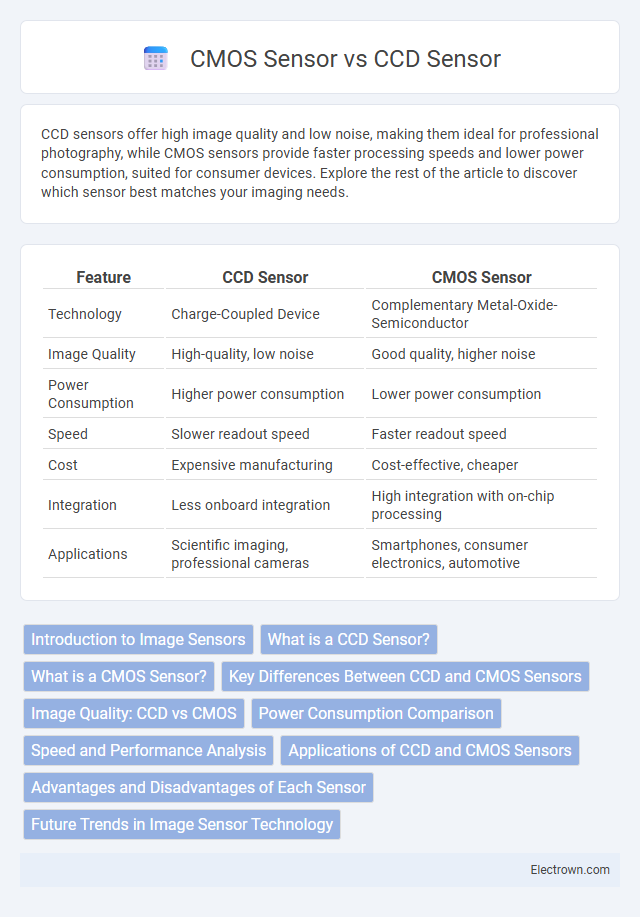CCD sensors offer high image quality and low noise, making them ideal for professional photography, while CMOS sensors provide faster processing speeds and lower power consumption, suited for consumer devices. Explore the rest of the article to discover which sensor best matches your imaging needs.
Table of Comparison
| Feature | CCD Sensor | CMOS Sensor |
|---|---|---|
| Technology | Charge-Coupled Device | Complementary Metal-Oxide-Semiconductor |
| Image Quality | High-quality, low noise | Good quality, higher noise |
| Power Consumption | Higher power consumption | Lower power consumption |
| Speed | Slower readout speed | Faster readout speed |
| Cost | Expensive manufacturing | Cost-effective, cheaper |
| Integration | Less onboard integration | High integration with on-chip processing |
| Applications | Scientific imaging, professional cameras | Smartphones, consumer electronics, automotive |
Introduction to Image Sensors
CCD (Charge-Coupled Device) and CMOS (Complementary Metal-Oxide-Semiconductor) sensors are crucial components in digital imaging technology, converting light into electronic signals to capture photographs. CCD sensors are known for their high-quality images with low noise, making them ideal for professional photography and scientific applications, while CMOS sensors offer faster processing speeds and lower power consumption, commonly used in smartphones and consumer cameras. The choice between CCD and CMOS depends on factors like image quality, cost, power efficiency, and application-specific requirements.
What is a CCD Sensor?
A CCD (Charge-Coupled Device) sensor captures images by converting light into electrical charges and transferring them across the chip to be processed, known for high image quality and low noise. This sensor type excels in professional photography and scientific applications where color accuracy and sensitivity are critical. Your choice of a CCD sensor ensures superior image clarity, especially in low-light environments.
What is a CMOS Sensor?
A CMOS sensor, or Complementary Metal-Oxide-Semiconductor sensor, is a type of image sensor used in digital cameras and imaging devices to convert light into electrical signals. CMOS sensors offer lower power consumption, faster processing speeds, and integration of additional circuitry on a single chip compared to CCD sensors, enhancing efficiency and functionality. Your choice of a CMOS sensor ensures improved performance in dynamic environments with reduced noise and higher frame rates.
Key Differences Between CCD and CMOS Sensors
CCD sensors excel in image quality with low noise and high sensitivity, making them ideal for professional photography and scientific imaging. CMOS sensors offer faster readout speeds, lower power consumption, and integration capabilities, which favor applications in smartphones and digital cameras. The fundamental difference lies in their electronic architecture: CCDs transfer charge across the chip to a single amplifier, while CMOS sensors have individual amplifiers at each pixel, enabling more flexible and efficient signal processing.
Image Quality: CCD vs CMOS
CCD sensors generally deliver higher image quality with superior light sensitivity, lower noise levels, and better color accuracy, making them ideal for professional photography and scientific imaging. CMOS sensors have improved significantly, offering competitive image quality with faster readout speeds, lower power consumption, and enhanced integration capabilities, suitable for consumer electronics and real-time applications. Advances in CMOS technology continue to narrow the gap, with modern CMOS sensors achieving comparable noise performance and dynamic range to CCDs in many use cases.
Power Consumption Comparison
CMOS sensors consume significantly less power than CCD sensors due to their on-chip circuitry that enables efficient signal processing. This lower power consumption makes CMOS ideal for battery-powered devices such as smartphones and portable cameras. In contrast, CCD sensors require higher power to transfer charge across the chip, resulting in increased energy usage and heat generation.
Speed and Performance Analysis
CMOS sensors excel in speed and performance due to their lower power consumption and faster readout capabilities, making them ideal for high-frame-rate video and real-time imaging applications. CCD sensors, while traditionally offering higher image quality with less noise, tend to operate slower because of their analog charge transfer process, limiting their efficiency in dynamic shooting environments. Your choice depends on whether you prioritize rapid data acquisition and energy efficiency (CMOS) or maximum image fidelity under controlled conditions (CCD).
Applications of CCD and CMOS Sensors
CCD sensors excel in applications requiring high image quality and low noise, such as scientific imaging, astronomy, and professional photography. CMOS sensors dominate in consumer electronics like smartphones, webcams, and automotive cameras due to their lower power consumption and faster readout speeds. Your choice between CCD and CMOS sensors depends on prioritizing image fidelity or integration flexibility for specific applications.
Advantages and Disadvantages of Each Sensor
CCD sensors excel in low-light sensitivity and produce high-quality images with less noise, making them ideal for professional photography and scientific applications. CMOS sensors offer advantages in speed, lower power consumption, and integration capabilities, enabling faster readout and cost-effective manufacturing for everyday use. Your choice depends on whether superior image quality or efficiency and affordability better suit your needs.
Future Trends in Image Sensor Technology
Future trends in image sensor technology emphasize the rise of CMOS sensors due to their lower power consumption, higher integration capabilities, and faster readout speeds compared to CCD sensors. Innovations like stacked CMOS designs and backside illumination significantly enhance image quality and sensitivity in low-light conditions. Emerging developments in quantum dot and organic photodetectors promise to further revolutionize sensor efficiency and color accuracy beyond current CCD and CMOS capabilities.
CCD vs CMOS sensor Infographic

 electrown.com
electrown.com